Menu Development, Planning and Design for The Coach Marlow
VerifiedAdded on 2022/12/26
|11
|3578
|69
Report
AI Summary
This report provides a comprehensive analysis of menu development, planning, and design, focusing on maximizing profitability for a restaurant, specifically The Coach Marlow. It begins with an introduction to menu planning, types of menus (static, cycle, and single-use), and principles of food planning, including balance, variety, and contrast. The report then delves into customer and business requirements, emphasizing the importance of menu engineering to promote profitable items, utilize relative pricing, manage menu size effectively, and maintain a clear and updated menu design. Furthermore, the report outlines a plan to develop a menu that meets these requirements, considering legal frameworks, positive competition, and menu updates. A sample menu for The Coach Marlow is presented, showcasing starters, main courses, and drinks. Finally, the report highlights the importance of menu design and engineering as a tool for understanding profit contribution and promoting sales.

Menu Development,
Planning and Design
Planning and Design
Secure Best Marks with AI Grader
Need help grading? Try our AI Grader for instant feedback on your assignments.
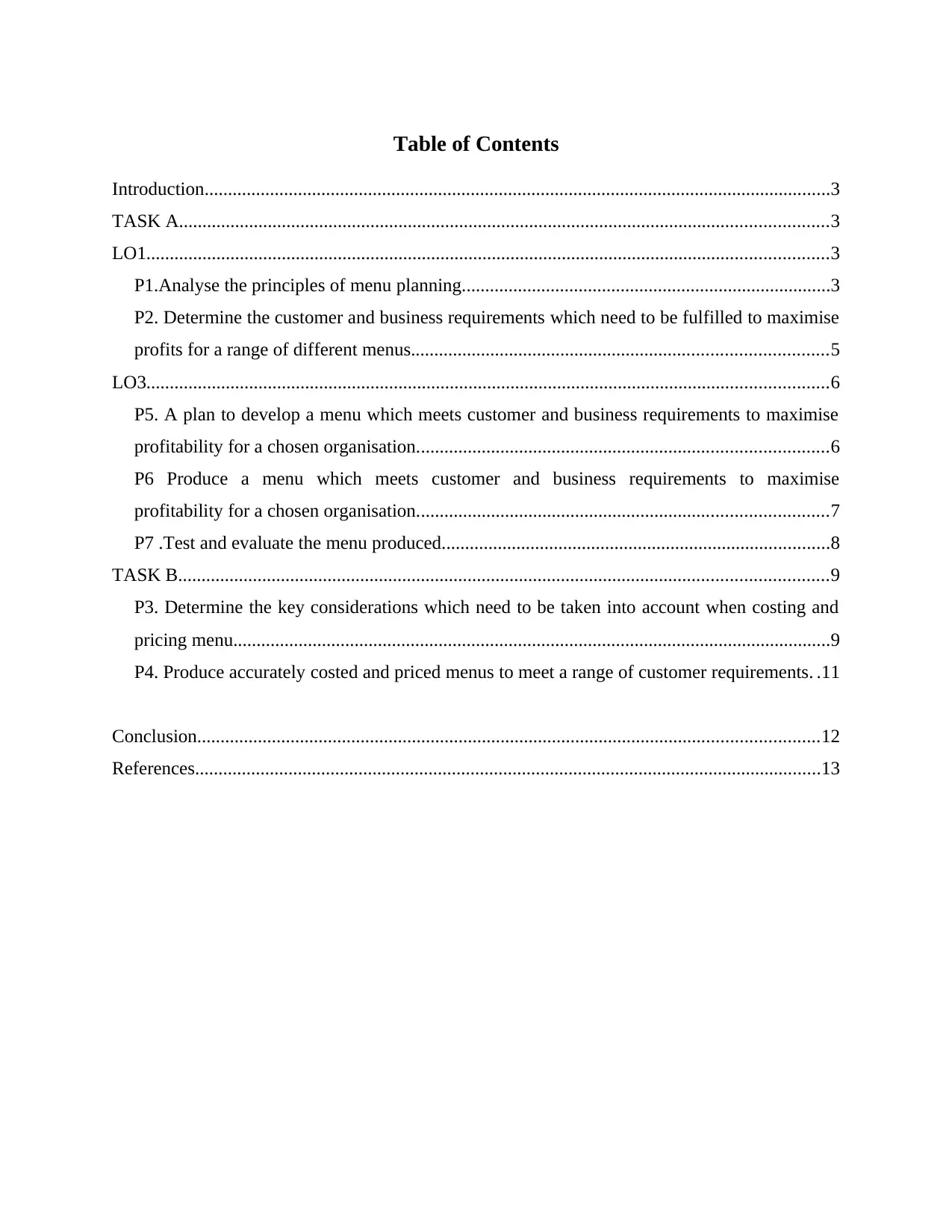
Table of Contents
Introduction......................................................................................................................................3
TASK A...........................................................................................................................................3
LO1..................................................................................................................................................3
P1.Analyse the principles of menu planning...............................................................................3
P2. Determine the customer and business requirements which need to be fulfilled to maximise
profits for a range of different menus.........................................................................................5
LO3..................................................................................................................................................6
P5. A plan to develop a menu which meets customer and business requirements to maximise
profitability for a chosen organisation........................................................................................6
P6 Produce a menu which meets customer and business requirements to maximise
profitability for a chosen organisation........................................................................................7
P7 .Test and evaluate the menu produced...................................................................................8
TASK B...........................................................................................................................................9
P3. Determine the key considerations which need to be taken into account when costing and
pricing menu................................................................................................................................9
P4. Produce accurately costed and priced menus to meet a range of customer requirements. .11
Conclusion.....................................................................................................................................12
References......................................................................................................................................13
Introduction......................................................................................................................................3
TASK A...........................................................................................................................................3
LO1..................................................................................................................................................3
P1.Analyse the principles of menu planning...............................................................................3
P2. Determine the customer and business requirements which need to be fulfilled to maximise
profits for a range of different menus.........................................................................................5
LO3..................................................................................................................................................6
P5. A plan to develop a menu which meets customer and business requirements to maximise
profitability for a chosen organisation........................................................................................6
P6 Produce a menu which meets customer and business requirements to maximise
profitability for a chosen organisation........................................................................................7
P7 .Test and evaluate the menu produced...................................................................................8
TASK B...........................................................................................................................................9
P3. Determine the key considerations which need to be taken into account when costing and
pricing menu................................................................................................................................9
P4. Produce accurately costed and priced menus to meet a range of customer requirements. .11
Conclusion.....................................................................................................................................12
References......................................................................................................................................13
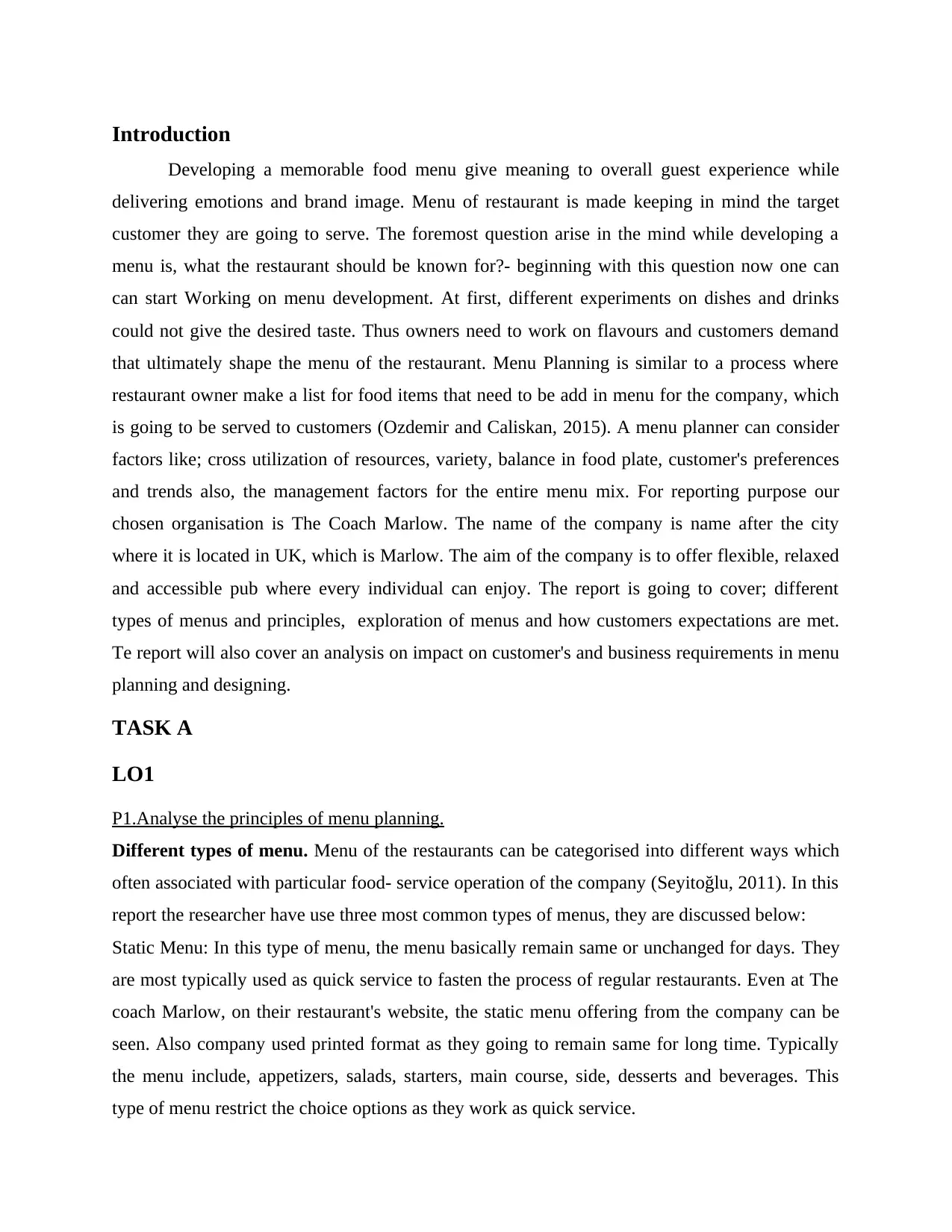
Introduction
Developing a memorable food menu give meaning to overall guest experience while
delivering emotions and brand image. Menu of restaurant is made keeping in mind the target
customer they are going to serve. The foremost question arise in the mind while developing a
menu is, what the restaurant should be known for?- beginning with this question now one can
can start Working on menu development. At first, different experiments on dishes and drinks
could not give the desired taste. Thus owners need to work on flavours and customers demand
that ultimately shape the menu of the restaurant. Menu Planning is similar to a process where
restaurant owner make a list for food items that need to be add in menu for the company, which
is going to be served to customers (Ozdemir and Caliskan, 2015). A menu planner can consider
factors like; cross utilization of resources, variety, balance in food plate, customer's preferences
and trends also, the management factors for the entire menu mix. For reporting purpose our
chosen organisation is The Coach Marlow. The name of the company is name after the city
where it is located in UK, which is Marlow. The aim of the company is to offer flexible, relaxed
and accessible pub where every individual can enjoy. The report is going to cover; different
types of menus and principles, exploration of menus and how customers expectations are met.
Te report will also cover an analysis on impact on customer's and business requirements in menu
planning and designing.
TASK A
LO1
P1.Analyse the principles of menu planning.
Different types of menu. Menu of the restaurants can be categorised into different ways which
often associated with particular food- service operation of the company (Seyitoğlu, 2011). In this
report the researcher have use three most common types of menus, they are discussed below:
Static Menu: In this type of menu, the menu basically remain same or unchanged for days. They
are most typically used as quick service to fasten the process of regular restaurants. Even at The
coach Marlow, on their restaurant's website, the static menu offering from the company can be
seen. Also company used printed format as they going to remain same for long time. Typically
the menu include, appetizers, salads, starters, main course, side, desserts and beverages. This
type of menu restrict the choice options as they work as quick service.
Developing a memorable food menu give meaning to overall guest experience while
delivering emotions and brand image. Menu of restaurant is made keeping in mind the target
customer they are going to serve. The foremost question arise in the mind while developing a
menu is, what the restaurant should be known for?- beginning with this question now one can
can start Working on menu development. At first, different experiments on dishes and drinks
could not give the desired taste. Thus owners need to work on flavours and customers demand
that ultimately shape the menu of the restaurant. Menu Planning is similar to a process where
restaurant owner make a list for food items that need to be add in menu for the company, which
is going to be served to customers (Ozdemir and Caliskan, 2015). A menu planner can consider
factors like; cross utilization of resources, variety, balance in food plate, customer's preferences
and trends also, the management factors for the entire menu mix. For reporting purpose our
chosen organisation is The Coach Marlow. The name of the company is name after the city
where it is located in UK, which is Marlow. The aim of the company is to offer flexible, relaxed
and accessible pub where every individual can enjoy. The report is going to cover; different
types of menus and principles, exploration of menus and how customers expectations are met.
Te report will also cover an analysis on impact on customer's and business requirements in menu
planning and designing.
TASK A
LO1
P1.Analyse the principles of menu planning.
Different types of menu. Menu of the restaurants can be categorised into different ways which
often associated with particular food- service operation of the company (Seyitoğlu, 2011). In this
report the researcher have use three most common types of menus, they are discussed below:
Static Menu: In this type of menu, the menu basically remain same or unchanged for days. They
are most typically used as quick service to fasten the process of regular restaurants. Even at The
coach Marlow, on their restaurant's website, the static menu offering from the company can be
seen. Also company used printed format as they going to remain same for long time. Typically
the menu include, appetizers, salads, starters, main course, side, desserts and beverages. This
type of menu restrict the choice options as they work as quick service.

Cycle Menu: In cycle menu, they are used in mostly non- commercial food-service operation
which means the restaurants offer some same group of customers on regular basis. This include;
corporate dining, schools, CCRC and healthcare etc. (Jones and Mifll, 2001) This type of menu
follow a particular pattern to meet the needs of its customers. The menu are also planned as
seasonal basis as food include as per the season it follows.
Single Use Menu: This type of menu are change on regular basis or maybe planned for any
special event with one time event for one time use only. This type menus are used to address the
fine dining experience to its customers. Single use menu are made to cater events like parties,
marriage or any special occasion.
A menu is a different set of options represented before customers with mentioned price to
it. It is prepared by the restaurant on the basis of their customers and their company's offering in
order to inform the availability of food they serve in their restaurant.
Principles of Food Planning. Menu planning strive to include right food balance in one plate,
food nutritional qualities, variety, colour, texture, flavour mixture finally shape , size and
representation of the food in the plate. The basic principle behind the food planning is organised
in to two areas, that is, customer satisfaction and management decision (Linassi, Alberton, and
Marinho, 2016). The two are need to be consider. The basic planning principles include, are as
follows:
Balance: Menus should be made in way that balance in must be maintain. Like ; right protein,
fibre, vitamins etc. with fat and sodium . Menu are designed to balance the flavour so that menu
does not reflect both as too spicy or too bland.
Express Variety: Restaurant include variety in their food menu not only help in ensure
adequate nutritional intake in plate but also keep the menu interesting and appealing in terms of
proper nutritional value per plate.
Add Contrast in the Plate: A food in plate must be contrasting in terms of colour, texture and
flavours.
Consider colour: Using different combination of colour in plate that compliment each food is
important. At least two different colour in food is appealing in each meal is a good practice.
Constraints of menu
which means the restaurants offer some same group of customers on regular basis. This include;
corporate dining, schools, CCRC and healthcare etc. (Jones and Mifll, 2001) This type of menu
follow a particular pattern to meet the needs of its customers. The menu are also planned as
seasonal basis as food include as per the season it follows.
Single Use Menu: This type of menu are change on regular basis or maybe planned for any
special event with one time event for one time use only. This type menus are used to address the
fine dining experience to its customers. Single use menu are made to cater events like parties,
marriage or any special occasion.
A menu is a different set of options represented before customers with mentioned price to
it. It is prepared by the restaurant on the basis of their customers and their company's offering in
order to inform the availability of food they serve in their restaurant.
Principles of Food Planning. Menu planning strive to include right food balance in one plate,
food nutritional qualities, variety, colour, texture, flavour mixture finally shape , size and
representation of the food in the plate. The basic principle behind the food planning is organised
in to two areas, that is, customer satisfaction and management decision (Linassi, Alberton, and
Marinho, 2016). The two are need to be consider. The basic planning principles include, are as
follows:
Balance: Menus should be made in way that balance in must be maintain. Like ; right protein,
fibre, vitamins etc. with fat and sodium . Menu are designed to balance the flavour so that menu
does not reflect both as too spicy or too bland.
Express Variety: Restaurant include variety in their food menu not only help in ensure
adequate nutritional intake in plate but also keep the menu interesting and appealing in terms of
proper nutritional value per plate.
Add Contrast in the Plate: A food in plate must be contrasting in terms of colour, texture and
flavours.
Consider colour: Using different combination of colour in plate that compliment each food is
important. At least two different colour in food is appealing in each meal is a good practice.
Constraints of menu
Secure Best Marks with AI Grader
Need help grading? Try our AI Grader for instant feedback on your assignments.
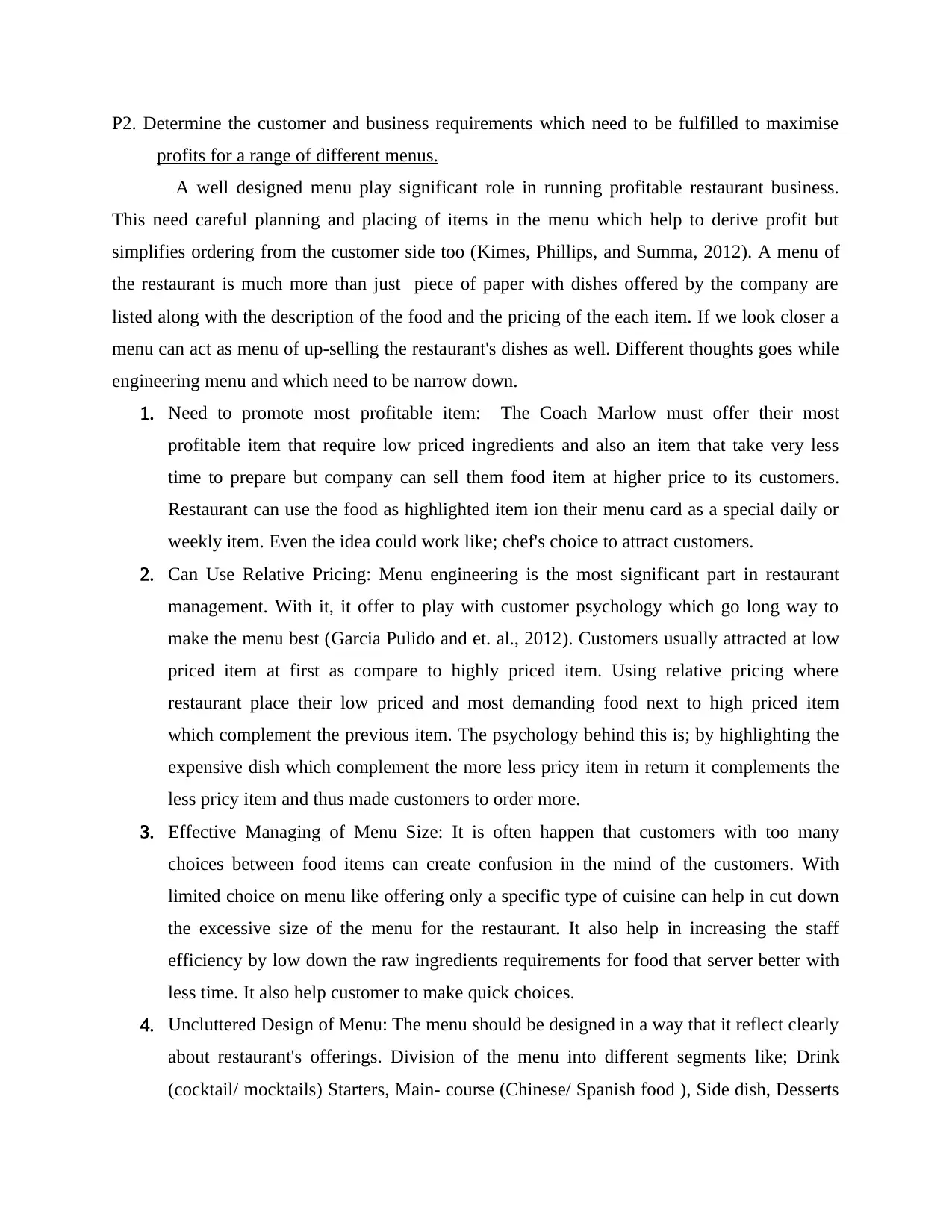
P2. Determine the customer and business requirements which need to be fulfilled to maximise
profits for a range of different menus.
A well designed menu play significant role in running profitable restaurant business.
This need careful planning and placing of items in the menu which help to derive profit but
simplifies ordering from the customer side too (Kimes, Phillips, and Summa, 2012). A menu of
the restaurant is much more than just piece of paper with dishes offered by the company are
listed along with the description of the food and the pricing of the each item. If we look closer a
menu can act as menu of up-selling the restaurant's dishes as well. Different thoughts goes while
engineering menu and which need to be narrow down.
1. Need to promote most profitable item: The Coach Marlow must offer their most
profitable item that require low priced ingredients and also an item that take very less
time to prepare but company can sell them food item at higher price to its customers.
Restaurant can use the food as highlighted item ion their menu card as a special daily or
weekly item. Even the idea could work like; chef's choice to attract customers.
2. Can Use Relative Pricing: Menu engineering is the most significant part in restaurant
management. With it, it offer to play with customer psychology which go long way to
make the menu best (Garcia Pulido and et. al., 2012). Customers usually attracted at low
priced item at first as compare to highly priced item. Using relative pricing where
restaurant place their low priced and most demanding food next to high priced item
which complement the previous item. The psychology behind this is; by highlighting the
expensive dish which complement the more less pricy item in return it complements the
less pricy item and thus made customers to order more.
3. Effective Managing of Menu Size: It is often happen that customers with too many
choices between food items can create confusion in the mind of the customers. With
limited choice on menu like offering only a specific type of cuisine can help in cut down
the excessive size of the menu for the restaurant. It also help in increasing the staff
efficiency by low down the raw ingredients requirements for food that server better with
less time. It also help customer to make quick choices.
4. Uncluttered Design of Menu: The menu should be designed in a way that it reflect clearly
about restaurant's offerings. Division of the menu into different segments like; Drink
(cocktail/ mocktails) Starters, Main- course (Chinese/ Spanish food ), Side dish, Desserts
profits for a range of different menus.
A well designed menu play significant role in running profitable restaurant business.
This need careful planning and placing of items in the menu which help to derive profit but
simplifies ordering from the customer side too (Kimes, Phillips, and Summa, 2012). A menu of
the restaurant is much more than just piece of paper with dishes offered by the company are
listed along with the description of the food and the pricing of the each item. If we look closer a
menu can act as menu of up-selling the restaurant's dishes as well. Different thoughts goes while
engineering menu and which need to be narrow down.
1. Need to promote most profitable item: The Coach Marlow must offer their most
profitable item that require low priced ingredients and also an item that take very less
time to prepare but company can sell them food item at higher price to its customers.
Restaurant can use the food as highlighted item ion their menu card as a special daily or
weekly item. Even the idea could work like; chef's choice to attract customers.
2. Can Use Relative Pricing: Menu engineering is the most significant part in restaurant
management. With it, it offer to play with customer psychology which go long way to
make the menu best (Garcia Pulido and et. al., 2012). Customers usually attracted at low
priced item at first as compare to highly priced item. Using relative pricing where
restaurant place their low priced and most demanding food next to high priced item
which complement the previous item. The psychology behind this is; by highlighting the
expensive dish which complement the more less pricy item in return it complements the
less pricy item and thus made customers to order more.
3. Effective Managing of Menu Size: It is often happen that customers with too many
choices between food items can create confusion in the mind of the customers. With
limited choice on menu like offering only a specific type of cuisine can help in cut down
the excessive size of the menu for the restaurant. It also help in increasing the staff
efficiency by low down the raw ingredients requirements for food that server better with
less time. It also help customer to make quick choices.
4. Uncluttered Design of Menu: The menu should be designed in a way that it reflect clearly
about restaurant's offerings. Division of the menu into different segments like; Drink
(cocktail/ mocktails) Starters, Main- course (Chinese/ Spanish food ), Side dish, Desserts
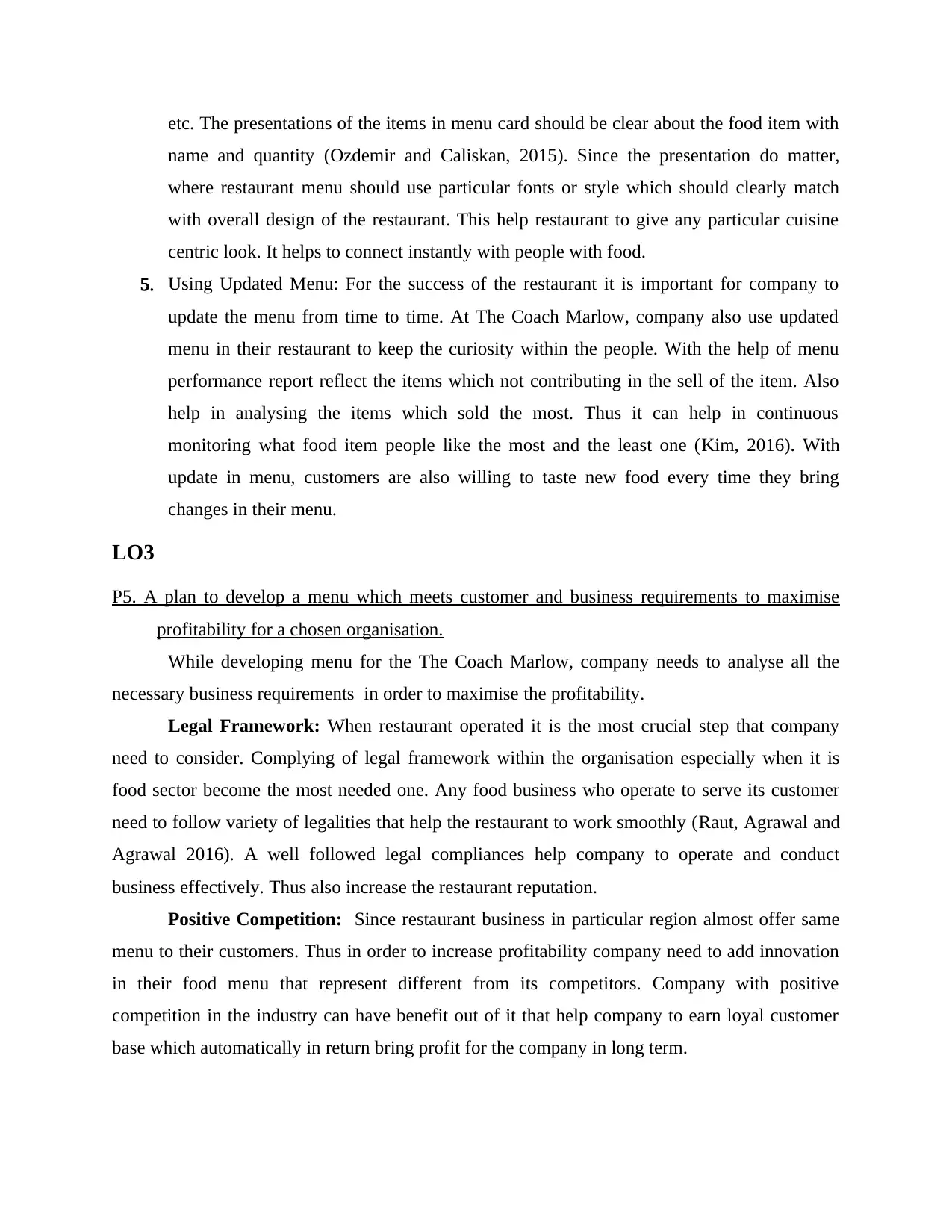
etc. The presentations of the items in menu card should be clear about the food item with
name and quantity (Ozdemir and Caliskan, 2015). Since the presentation do matter,
where restaurant menu should use particular fonts or style which should clearly match
with overall design of the restaurant. This help restaurant to give any particular cuisine
centric look. It helps to connect instantly with people with food.
5. Using Updated Menu: For the success of the restaurant it is important for company to
update the menu from time to time. At The Coach Marlow, company also use updated
menu in their restaurant to keep the curiosity within the people. With the help of menu
performance report reflect the items which not contributing in the sell of the item. Also
help in analysing the items which sold the most. Thus it can help in continuous
monitoring what food item people like the most and the least one (Kim, 2016). With
update in menu, customers are also willing to taste new food every time they bring
changes in their menu.
LO3
P5. A plan to develop a menu which meets customer and business requirements to maximise
profitability for a chosen organisation.
While developing menu for the The Coach Marlow, company needs to analyse all the
necessary business requirements in order to maximise the profitability.
Legal Framework: When restaurant operated it is the most crucial step that company
need to consider. Complying of legal framework within the organisation especially when it is
food sector become the most needed one. Any food business who operate to serve its customer
need to follow variety of legalities that help the restaurant to work smoothly (Raut, Agrawal and
Agrawal 2016). A well followed legal compliances help company to operate and conduct
business effectively. Thus also increase the restaurant reputation.
Positive Competition: Since restaurant business in particular region almost offer same
menu to their customers. Thus in order to increase profitability company need to add innovation
in their food menu that represent different from its competitors. Company with positive
competition in the industry can have benefit out of it that help company to earn loyal customer
base which automatically in return bring profit for the company in long term.
name and quantity (Ozdemir and Caliskan, 2015). Since the presentation do matter,
where restaurant menu should use particular fonts or style which should clearly match
with overall design of the restaurant. This help restaurant to give any particular cuisine
centric look. It helps to connect instantly with people with food.
5. Using Updated Menu: For the success of the restaurant it is important for company to
update the menu from time to time. At The Coach Marlow, company also use updated
menu in their restaurant to keep the curiosity within the people. With the help of menu
performance report reflect the items which not contributing in the sell of the item. Also
help in analysing the items which sold the most. Thus it can help in continuous
monitoring what food item people like the most and the least one (Kim, 2016). With
update in menu, customers are also willing to taste new food every time they bring
changes in their menu.
LO3
P5. A plan to develop a menu which meets customer and business requirements to maximise
profitability for a chosen organisation.
While developing menu for the The Coach Marlow, company needs to analyse all the
necessary business requirements in order to maximise the profitability.
Legal Framework: When restaurant operated it is the most crucial step that company
need to consider. Complying of legal framework within the organisation especially when it is
food sector become the most needed one. Any food business who operate to serve its customer
need to follow variety of legalities that help the restaurant to work smoothly (Raut, Agrawal and
Agrawal 2016). A well followed legal compliances help company to operate and conduct
business effectively. Thus also increase the restaurant reputation.
Positive Competition: Since restaurant business in particular region almost offer same
menu to their customers. Thus in order to increase profitability company need to add innovation
in their food menu that represent different from its competitors. Company with positive
competition in the industry can have benefit out of it that help company to earn loyal customer
base which automatically in return bring profit for the company in long term.
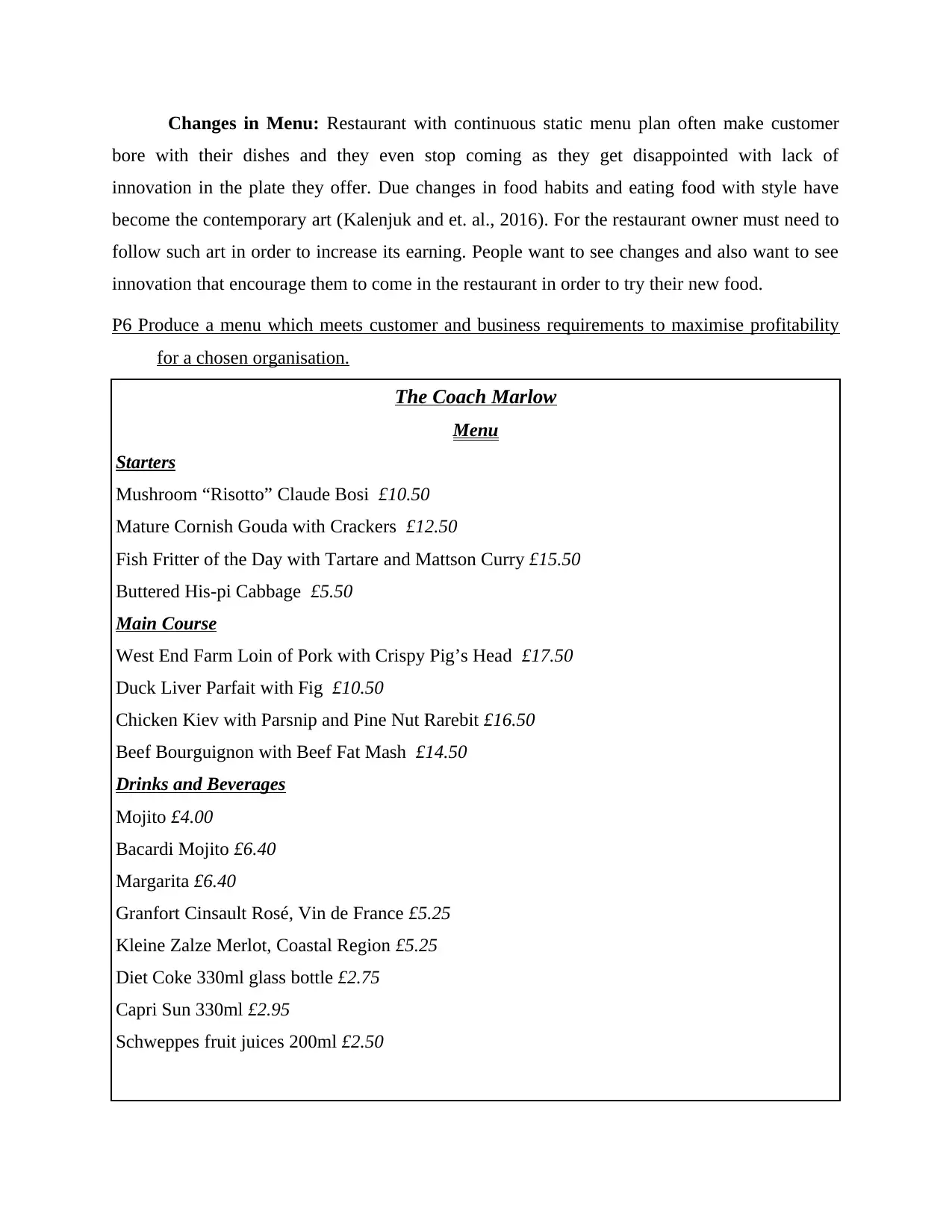
Changes in Menu: Restaurant with continuous static menu plan often make customer
bore with their dishes and they even stop coming as they get disappointed with lack of
innovation in the plate they offer. Due changes in food habits and eating food with style have
become the contemporary art (Kalenjuk and et. al., 2016). For the restaurant owner must need to
follow such art in order to increase its earning. People want to see changes and also want to see
innovation that encourage them to come in the restaurant in order to try their new food.
P6 Produce a menu which meets customer and business requirements to maximise profitability
for a chosen organisation.
The Coach Marlow
Menu
Starters
Mushroom “Risotto” Claude Bosi £10.50
Mature Cornish Gouda with Crackers £12.50
Fish Fritter of the Day with Tartare and Mattson Curry £15.50
Buttered His-pi Cabbage £5.50
Main Course
West End Farm Loin of Pork with Crispy Pig’s Head £17.50
Duck Liver Parfait with Fig £10.50
Chicken Kiev with Parsnip and Pine Nut Rarebit £16.50
Beef Bourguignon with Beef Fat Mash £14.50
Drinks and Beverages
Mojito £4.00
Bacardi Mojito £6.40
Margarita £6.40
Granfort Cinsault Rosé, Vin de France £5.25
Kleine Zalze Merlot, Coastal Region £5.25
Diet Coke 330ml glass bottle £2.75
Capri Sun 330ml £2.95
Schweppes fruit juices 200ml £2.50
bore with their dishes and they even stop coming as they get disappointed with lack of
innovation in the plate they offer. Due changes in food habits and eating food with style have
become the contemporary art (Kalenjuk and et. al., 2016). For the restaurant owner must need to
follow such art in order to increase its earning. People want to see changes and also want to see
innovation that encourage them to come in the restaurant in order to try their new food.
P6 Produce a menu which meets customer and business requirements to maximise profitability
for a chosen organisation.
The Coach Marlow
Menu
Starters
Mushroom “Risotto” Claude Bosi £10.50
Mature Cornish Gouda with Crackers £12.50
Fish Fritter of the Day with Tartare and Mattson Curry £15.50
Buttered His-pi Cabbage £5.50
Main Course
West End Farm Loin of Pork with Crispy Pig’s Head £17.50
Duck Liver Parfait with Fig £10.50
Chicken Kiev with Parsnip and Pine Nut Rarebit £16.50
Beef Bourguignon with Beef Fat Mash £14.50
Drinks and Beverages
Mojito £4.00
Bacardi Mojito £6.40
Margarita £6.40
Granfort Cinsault Rosé, Vin de France £5.25
Kleine Zalze Merlot, Coastal Region £5.25
Diet Coke 330ml glass bottle £2.75
Capri Sun 330ml £2.95
Schweppes fruit juices 200ml £2.50
Paraphrase This Document
Need a fresh take? Get an instant paraphrase of this document with our AI Paraphraser

Menu design and engineering is the easy process of placement the restaurant's menu item
in one place. The main benefit of menu engineering is the understanding the profit contribution
for each of the item present in the menu. It is can be used as valuable tool for analyzing the
different combinations of the product of restaurant menu card that become an essential factor in
promotion of sell of the item (Radwan, Faroukh and Obaid, 2017). Menu engineering in simple
terms can be said that, it is the logical process of selecting, costing, pricing of final output of the
restaurant and finally evaluation of all the items in the menu card. While designing menu for the
restaurant few points need to be taken account. Such as;
Conducting satisfactory menu research that is. Considering the competitors and their
offerings, marketing, location etc. before design the menu.
Cross checking for the raw material availability, in order to produce final product for the
customers. Menu always need not to be fancy all the time. By keeping simple but
excellent in flavour is the key ingredient to attract customers. Ensuring consistent food
supply of raw materials on time before making any dish.
Keeping the target customer and their preference in the mind is the ultimate goal of the
restaurant. The most primary thing need to be considered that menu should have items
that march with the taste of restaurant target customers.
P7 .Test and evaluate the menu produced.
In The Coach Marlow, in order to measure the success of the organisation different
performance measurement techniques can be used, Such as:
KPI: This is a measurement technique that exhibit how effectively a company is achieving its
key objectives. In Coach Marlow, the company with the help of quantifiable measurements can
measure the company's performance for long term basis. KPI help in deciding the company's
strategic, financial and operational achievement in terms of other company in the same industry
(Baiomy, Jones and Goode, 2019). In simple terms company can still improve with all measuring
indicators that will help gauge the success in terms of objectives, targets and industrial rivalry.
Benchmarking: It is an approach of setting objectives and thus measuring those objectives with
achievable goals. The approach can help in improving restaurant's performance by learning from
its best practice and the process they have achieved. It act as a standard point for the company
where its performances get judged. Coach Marlow, can compare its current performance with
in one place. The main benefit of menu engineering is the understanding the profit contribution
for each of the item present in the menu. It is can be used as valuable tool for analyzing the
different combinations of the product of restaurant menu card that become an essential factor in
promotion of sell of the item (Radwan, Faroukh and Obaid, 2017). Menu engineering in simple
terms can be said that, it is the logical process of selecting, costing, pricing of final output of the
restaurant and finally evaluation of all the items in the menu card. While designing menu for the
restaurant few points need to be taken account. Such as;
Conducting satisfactory menu research that is. Considering the competitors and their
offerings, marketing, location etc. before design the menu.
Cross checking for the raw material availability, in order to produce final product for the
customers. Menu always need not to be fancy all the time. By keeping simple but
excellent in flavour is the key ingredient to attract customers. Ensuring consistent food
supply of raw materials on time before making any dish.
Keeping the target customer and their preference in the mind is the ultimate goal of the
restaurant. The most primary thing need to be considered that menu should have items
that march with the taste of restaurant target customers.
P7 .Test and evaluate the menu produced.
In The Coach Marlow, in order to measure the success of the organisation different
performance measurement techniques can be used, Such as:
KPI: This is a measurement technique that exhibit how effectively a company is achieving its
key objectives. In Coach Marlow, the company with the help of quantifiable measurements can
measure the company's performance for long term basis. KPI help in deciding the company's
strategic, financial and operational achievement in terms of other company in the same industry
(Baiomy, Jones and Goode, 2019). In simple terms company can still improve with all measuring
indicators that will help gauge the success in terms of objectives, targets and industrial rivalry.
Benchmarking: It is an approach of setting objectives and thus measuring those objectives with
achievable goals. The approach can help in improving restaurant's performance by learning from
its best practice and the process they have achieved. It act as a standard point for the company
where its performances get judged. Coach Marlow, can compare its current performance with
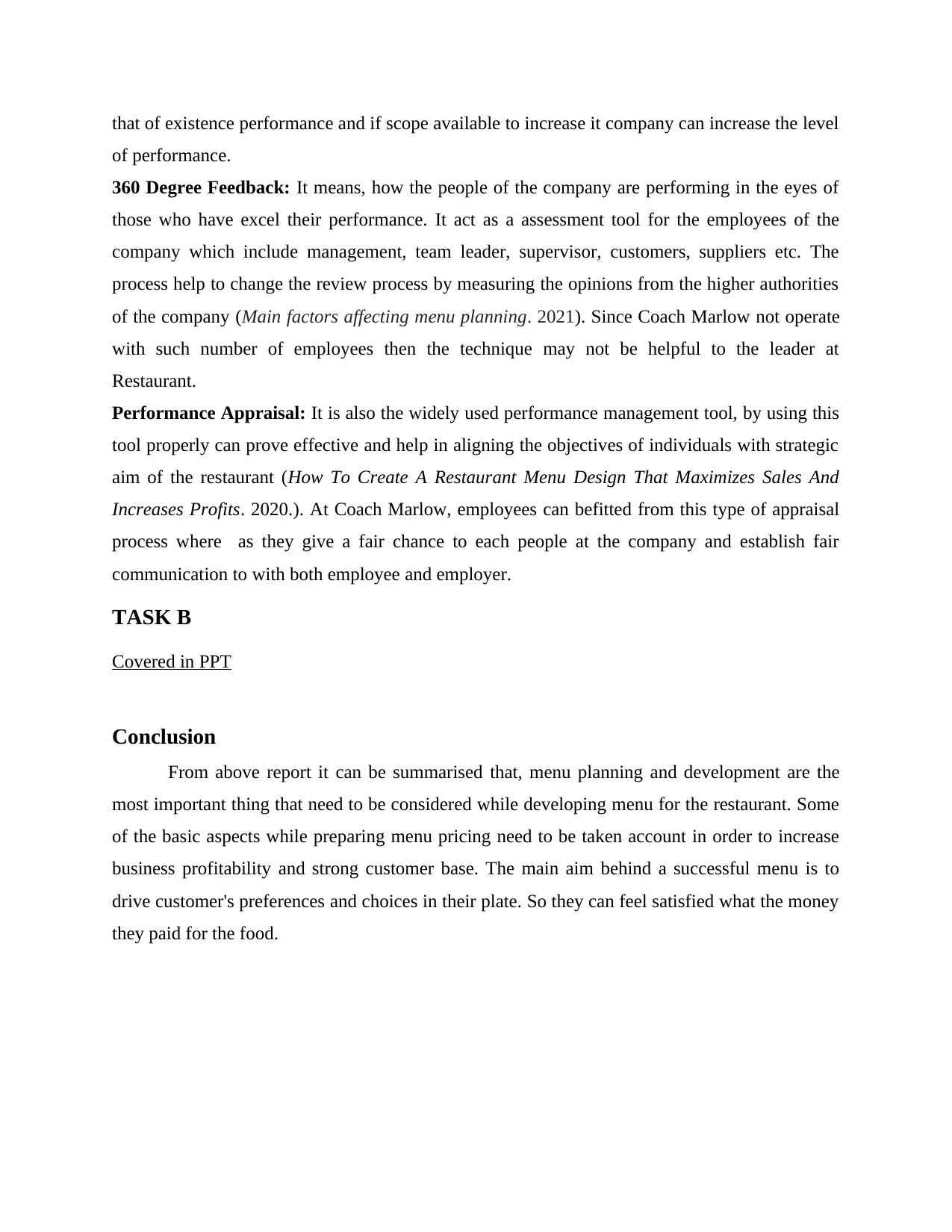
that of existence performance and if scope available to increase it company can increase the level
of performance.
360 Degree Feedback: It means, how the people of the company are performing in the eyes of
those who have excel their performance. It act as a assessment tool for the employees of the
company which include management, team leader, supervisor, customers, suppliers etc. The
process help to change the review process by measuring the opinions from the higher authorities
of the company (Main factors affecting menu planning. 2021). Since Coach Marlow not operate
with such number of employees then the technique may not be helpful to the leader at
Restaurant.
Performance Appraisal: It is also the widely used performance management tool, by using this
tool properly can prove effective and help in aligning the objectives of individuals with strategic
aim of the restaurant (How To Create A Restaurant Menu Design That Maximizes Sales And
Increases Profits. 2020.). At Coach Marlow, employees can befitted from this type of appraisal
process where as they give a fair chance to each people at the company and establish fair
communication to with both employee and employer.
TASK B
Covered in PPT
Conclusion
From above report it can be summarised that, menu planning and development are the
most important thing that need to be considered while developing menu for the restaurant. Some
of the basic aspects while preparing menu pricing need to be taken account in order to increase
business profitability and strong customer base. The main aim behind a successful menu is to
drive customer's preferences and choices in their plate. So they can feel satisfied what the money
they paid for the food.
of performance.
360 Degree Feedback: It means, how the people of the company are performing in the eyes of
those who have excel their performance. It act as a assessment tool for the employees of the
company which include management, team leader, supervisor, customers, suppliers etc. The
process help to change the review process by measuring the opinions from the higher authorities
of the company (Main factors affecting menu planning. 2021). Since Coach Marlow not operate
with such number of employees then the technique may not be helpful to the leader at
Restaurant.
Performance Appraisal: It is also the widely used performance management tool, by using this
tool properly can prove effective and help in aligning the objectives of individuals with strategic
aim of the restaurant (How To Create A Restaurant Menu Design That Maximizes Sales And
Increases Profits. 2020.). At Coach Marlow, employees can befitted from this type of appraisal
process where as they give a fair chance to each people at the company and establish fair
communication to with both employee and employer.
TASK B
Covered in PPT
Conclusion
From above report it can be summarised that, menu planning and development are the
most important thing that need to be considered while developing menu for the restaurant. Some
of the basic aspects while preparing menu pricing need to be taken account in order to increase
business profitability and strong customer base. The main aim behind a successful menu is to
drive customer's preferences and choices in their plate. So they can feel satisfied what the money
they paid for the food.
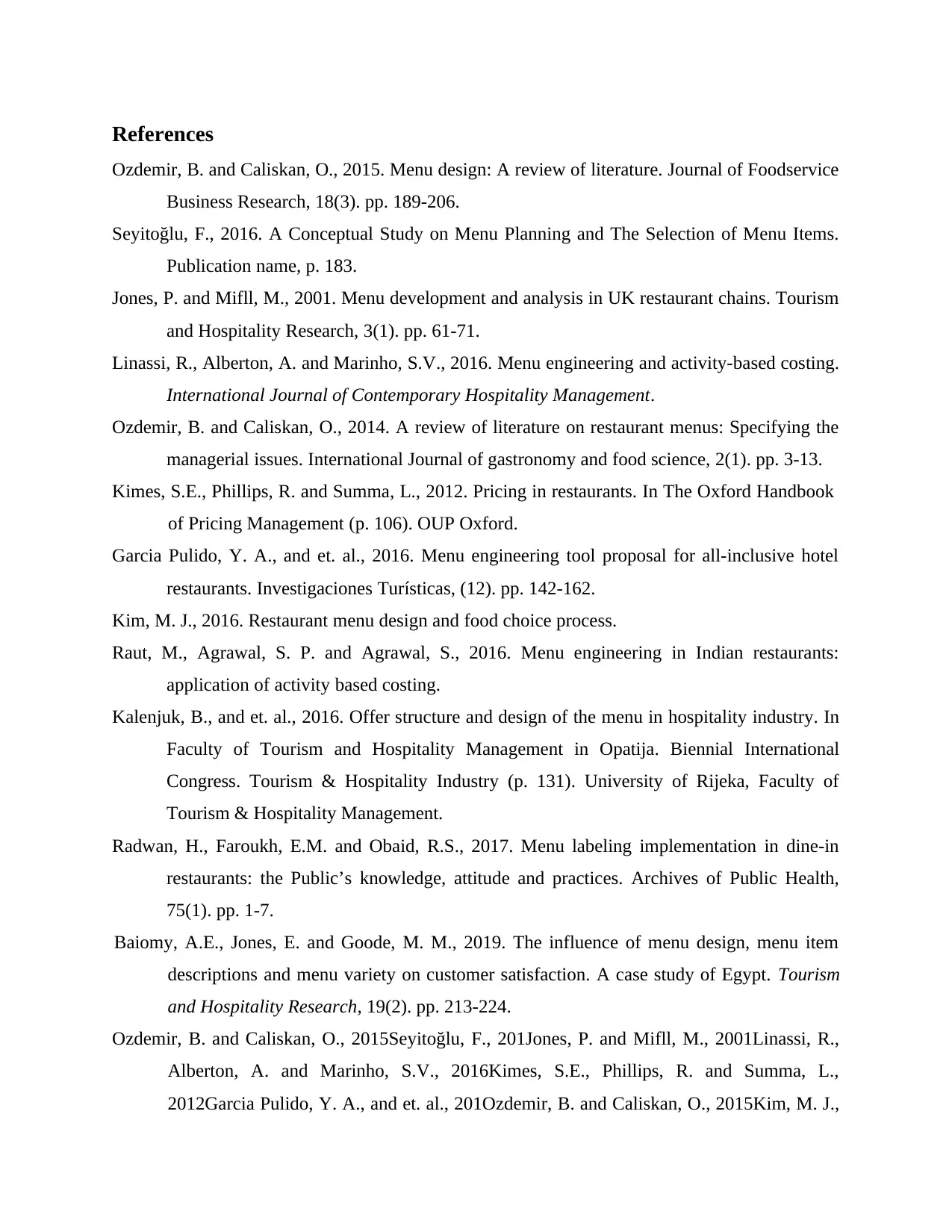
References
Ozdemir, B. and Caliskan, O., 2015. Menu design: A review of literature. Journal of Foodservice
Business Research, 18(3). pp. 189-206.
Seyitoğlu, F., 2016. A Conceptual Study on Menu Planning and The Selection of Menu Items.
Publication name, p. 183.
Jones, P. and Mifll, M., 2001. Menu development and analysis in UK restaurant chains. Tourism
and Hospitality Research, 3(1). pp. 61-71.
Linassi, R., Alberton, A. and Marinho, S.V., 2016. Menu engineering and activity-based costing.
International Journal of Contemporary Hospitality Management.
Ozdemir, B. and Caliskan, O., 2014. A review of literature on restaurant menus: Specifying the
managerial issues. International Journal of gastronomy and food science, 2(1). pp. 3-13.
Kimes, S.E., Phillips, R. and Summa, L., 2012. Pricing in restaurants. In The Oxford Handbook
of Pricing Management (p. 106). OUP Oxford.
Garcia Pulido, Y. A., and et. al., 2016. Menu engineering tool proposal for all-inclusive hotel
restaurants. Investigaciones Turísticas, (12). pp. 142-162.
Kim, M. J., 2016. Restaurant menu design and food choice process.
Raut, M., Agrawal, S. P. and Agrawal, S., 2016. Menu engineering in Indian restaurants:
application of activity based costing.
Kalenjuk, B., and et. al., 2016. Offer structure and design of the menu in hospitality industry. In
Faculty of Tourism and Hospitality Management in Opatija. Biennial International
Congress. Tourism & Hospitality Industry (p. 131). University of Rijeka, Faculty of
Tourism & Hospitality Management.
Radwan, H., Faroukh, E.M. and Obaid, R.S., 2017. Menu labeling implementation in dine-in
restaurants: the Public’s knowledge, attitude and practices. Archives of Public Health,
75(1). pp. 1-7.
Baiomy, A.E., Jones, E. and Goode, M. M., 2019. The influence of menu design, menu item
descriptions and menu variety on customer satisfaction. A case study of Egypt. Tourism
and Hospitality Research, 19(2). pp. 213-224.
Ozdemir, B. and Caliskan, O., 2015Seyitoğlu, F., 201Jones, P. and Mifll, M., 2001Linassi, R.,
Alberton, A. and Marinho, S.V., 2016Kimes, S.E., Phillips, R. and Summa, L.,
2012Garcia Pulido, Y. A., and et. al., 201Ozdemir, B. and Caliskan, O., 2015Kim, M. J.,
Ozdemir, B. and Caliskan, O., 2015. Menu design: A review of literature. Journal of Foodservice
Business Research, 18(3). pp. 189-206.
Seyitoğlu, F., 2016. A Conceptual Study on Menu Planning and The Selection of Menu Items.
Publication name, p. 183.
Jones, P. and Mifll, M., 2001. Menu development and analysis in UK restaurant chains. Tourism
and Hospitality Research, 3(1). pp. 61-71.
Linassi, R., Alberton, A. and Marinho, S.V., 2016. Menu engineering and activity-based costing.
International Journal of Contemporary Hospitality Management.
Ozdemir, B. and Caliskan, O., 2014. A review of literature on restaurant menus: Specifying the
managerial issues. International Journal of gastronomy and food science, 2(1). pp. 3-13.
Kimes, S.E., Phillips, R. and Summa, L., 2012. Pricing in restaurants. In The Oxford Handbook
of Pricing Management (p. 106). OUP Oxford.
Garcia Pulido, Y. A., and et. al., 2016. Menu engineering tool proposal for all-inclusive hotel
restaurants. Investigaciones Turísticas, (12). pp. 142-162.
Kim, M. J., 2016. Restaurant menu design and food choice process.
Raut, M., Agrawal, S. P. and Agrawal, S., 2016. Menu engineering in Indian restaurants:
application of activity based costing.
Kalenjuk, B., and et. al., 2016. Offer structure and design of the menu in hospitality industry. In
Faculty of Tourism and Hospitality Management in Opatija. Biennial International
Congress. Tourism & Hospitality Industry (p. 131). University of Rijeka, Faculty of
Tourism & Hospitality Management.
Radwan, H., Faroukh, E.M. and Obaid, R.S., 2017. Menu labeling implementation in dine-in
restaurants: the Public’s knowledge, attitude and practices. Archives of Public Health,
75(1). pp. 1-7.
Baiomy, A.E., Jones, E. and Goode, M. M., 2019. The influence of menu design, menu item
descriptions and menu variety on customer satisfaction. A case study of Egypt. Tourism
and Hospitality Research, 19(2). pp. 213-224.
Ozdemir, B. and Caliskan, O., 2015Seyitoğlu, F., 201Jones, P. and Mifll, M., 2001Linassi, R.,
Alberton, A. and Marinho, S.V., 2016Kimes, S.E., Phillips, R. and Summa, L.,
2012Garcia Pulido, Y. A., and et. al., 201Ozdemir, B. and Caliskan, O., 2015Kim, M. J.,
Secure Best Marks with AI Grader
Need help grading? Try our AI Grader for instant feedback on your assignments.

2016Raut, M., Agrawal, S. P. and Agrawal, S., 2016Kalenjuk, B., and et. al.,
2016.Radwan, H., Faroukh, E.M. and Obaid, R.S., 2017Baiomy, A.E., Jones, E. and
Goode, M.M., 2019
Freitas, A.L.P. and de Lima, J.D.C., 2020. WHAT ARE THE FACTORS THAT MOST
AFFECT SERVICE QUALITY IN FAST-FOOD RESTAURANTS?. Proceedings on
Engineering, 2(4), pp.419-430.
Online
Main factors affecting menu planning. 2021. [online] Available through:<
https://setupmyhotel.com/train-my-hotel-staff/f-and-b/782-main-factors-to-consider-
while-menu-planning.html>
How To Create A Restaurant Menu Design That Maximizes Sales And Increases Profits. 2020.
[online] Available
through:<https://www.posist.com/restaurant-times/resources/restaurant-menu-design-
maximizes-sales-increases-profits.html>
Basic Kitchen and Food Service Management. 2020. [online] Available through:<
https://psu.pb.unizin.org/hmd329/chapter/ch8/>
2016.Radwan, H., Faroukh, E.M. and Obaid, R.S., 2017Baiomy, A.E., Jones, E. and
Goode, M.M., 2019
Freitas, A.L.P. and de Lima, J.D.C., 2020. WHAT ARE THE FACTORS THAT MOST
AFFECT SERVICE QUALITY IN FAST-FOOD RESTAURANTS?. Proceedings on
Engineering, 2(4), pp.419-430.
Online
Main factors affecting menu planning. 2021. [online] Available through:<
https://setupmyhotel.com/train-my-hotel-staff/f-and-b/782-main-factors-to-consider-
while-menu-planning.html>
How To Create A Restaurant Menu Design That Maximizes Sales And Increases Profits. 2020.
[online] Available
through:<https://www.posist.com/restaurant-times/resources/restaurant-menu-design-
maximizes-sales-increases-profits.html>
Basic Kitchen and Food Service Management. 2020. [online] Available through:<
https://psu.pb.unizin.org/hmd329/chapter/ch8/>
1 out of 11
Related Documents
Your All-in-One AI-Powered Toolkit for Academic Success.
+13062052269
info@desklib.com
Available 24*7 on WhatsApp / Email
![[object Object]](/_next/static/media/star-bottom.7253800d.svg)
Unlock your academic potential
© 2024 | Zucol Services PVT LTD | All rights reserved.




